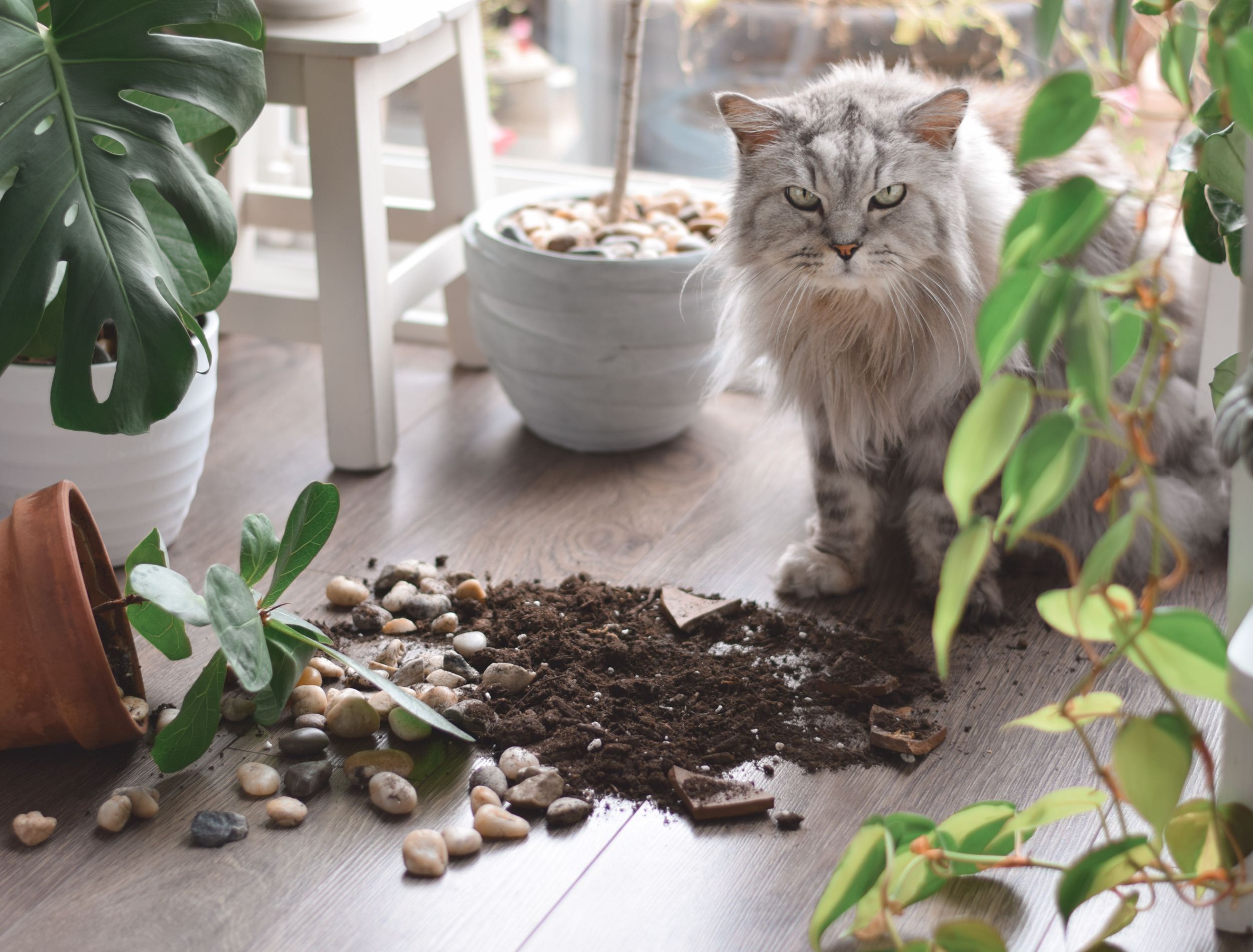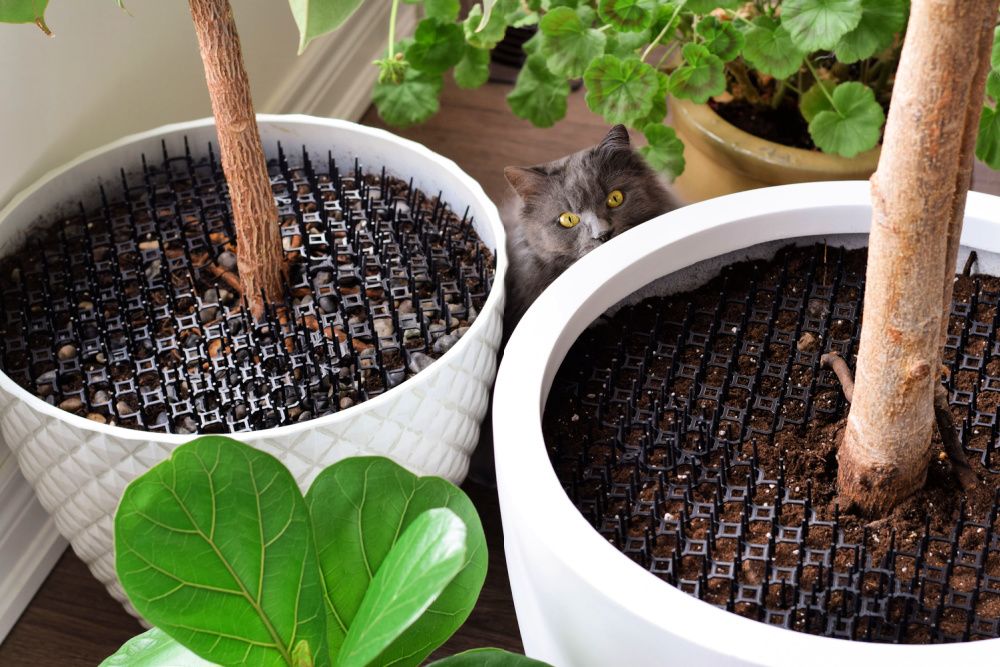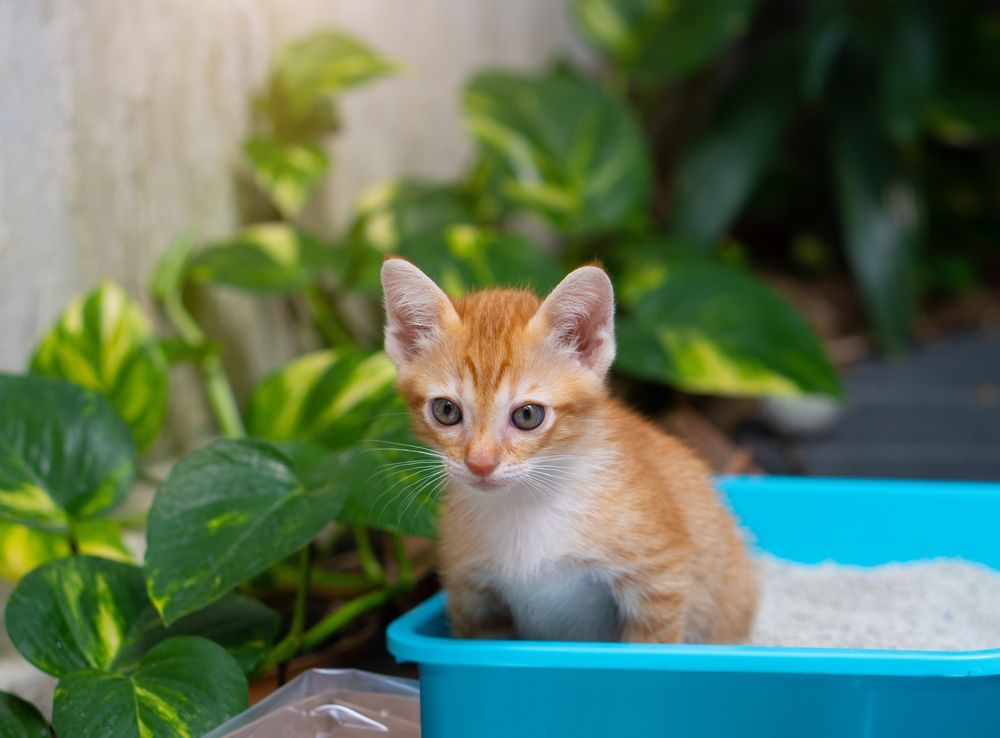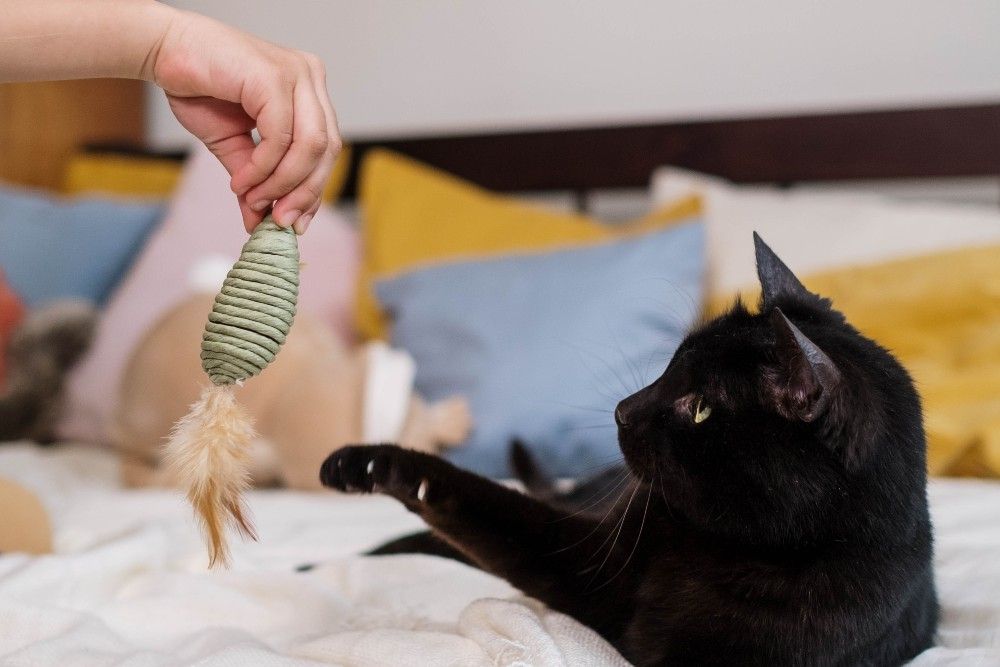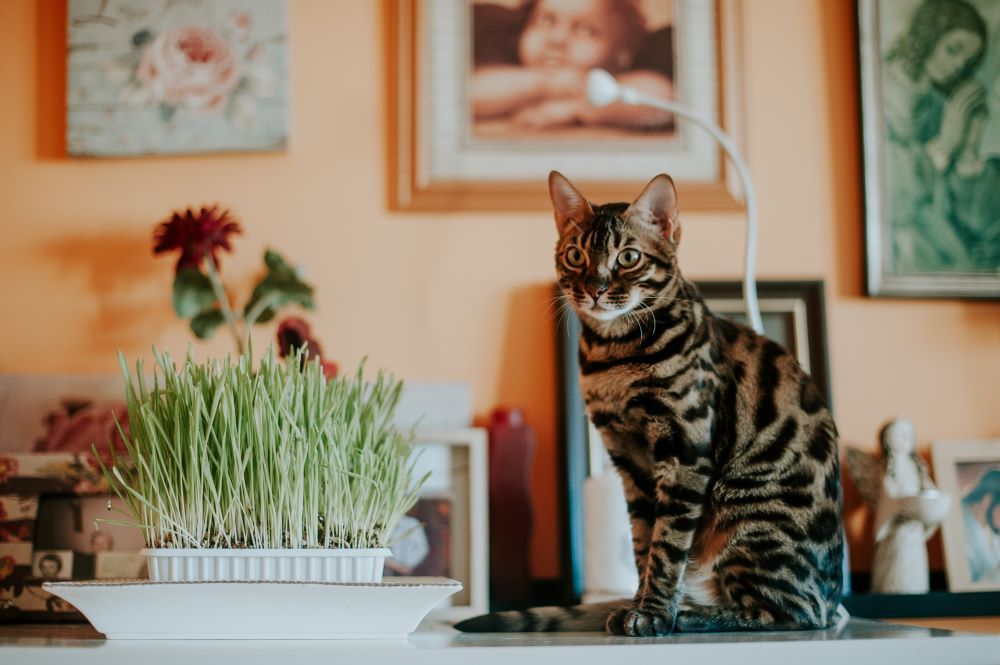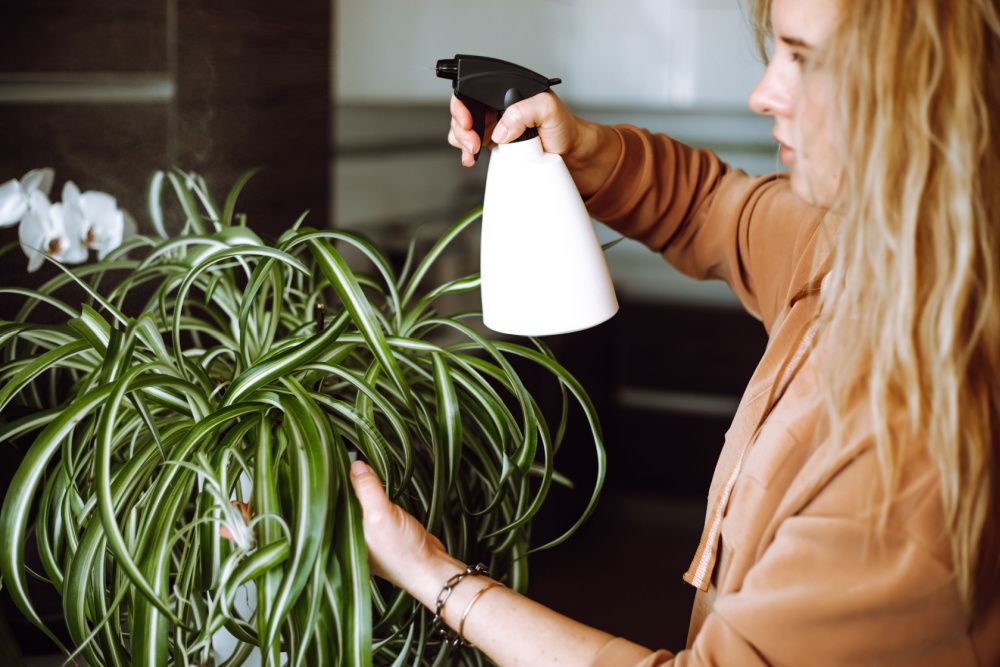Key Takeaways
- Create a barrier using stone mulch, cat spike mats, or aluminum foil to deter your cat from digging up the soil in your houseplants.
- Place your indoor plants out of reach from your cat by using high shelves or removing items that could serve as stepping stones.
- Opt for cat-friendly houseplants that are non-toxic, such as spider plants, Boston ferns, and Christmas cacti, to keep your cat safe and healthy.
Are you struggling to keep a mischievous cat away from your indoor houseplants? While keeping your cat happy and healthy indoors is a top priority, that doesn't mean you need to give up your love of indoor gardening! With a few minor tweaks and changes, you can still have plenty of plants in your home and keep your cat safe at the same time.
Learn how to keep cats out of your houseplants, so your indoor garden can continue thriving!
Create a Protective Barrier for Your Plants
Add stone mulch, cat spike mats, or aluminum foil
One of the best things you can do to deter your cat from your houseplants is to add a layer of stones or cat-repellent spikes to their pots.
- Stone mulch and cat spike mats work by creating a barrier that discourages your cat from giving in to its natural instinct and digging up the soil, creating a mess in your home.
- Both prevent your cat from being able to easily access the potting soil, along with removing the temptation for most cats.
- Layer the stones, placing multiple stones on top of one another, and completely cover the top layer of soil. By placing the stones like this, your cat will have a harder time getting into your potting soil to cause damage.
- Cat spike mats can be purchased online and placed directly on top of the soil. While they don't cause any pain to your cat if they do happen to step on them, the surface is uneven and uncomfortable for them to walk on.
- Another easy solution is to place aluminum foil around the base of your plants. The sound of aluminum foil crinkling combined with the strange texture makes it uncomfortable for cats, discouraging them from exploring the area.
Place Your Indoor Plants Out of Reach
Keep houseplants in an unattainable location
Another viable solution is to simply keep your houseplants out of reach from your cats. While cats naturally love to climb and explore, you can stop them by putting plants in an unattainable location in your home.
- Make vertical space work to your advantage by placing your plants on high shelves and in places your cat cannot access within your home.
- Install high enough wall shelves, so your cat won't be able to reach the plants you have on display, protecting them from unwelcome visitors.
- Take note of any taller furniture or items that may serve as a stepping stone for your cat, helping them access these spaces, and remove them.
Select Cat-Friendly Houseplants
Opt for non-toxic plants that are safe for cats
As a cat lover and owner, you want the best for your furry friend. If you have a cat that is persistently playing in or digging up your houseplants, it's important to make sure that these plants are not harmful to your pet.
- You may not be aware that many common houseplants are often toxic to your cat and can harm their health and well-being.
- In general, cats have a natural curiosity that will lead them to check out plants that you choose to bring into your home. This includes exploring any new plants and sometimes even tasting their stems and leaves, which can lead to serious health complications and even prove fatal if you aren’t careful to stick to non-toxic houseplants.
- If you are looking to share your home with a cat (or dog) and still have a variety of houseplants, you want to ensure that you are familiar with which plants are poisonous or toxic to cats.
- Some of the most popular non-toxic houseplants for cats include spider plants, Boston ferns, baby rubber plants, parlor palms, Areca palms, prayer plants, Christmas cacti, and African violets.
While this can be discouraging if you are an avid houseplant collector, overall, the safest choice is to assume that your cat will have access at one time or another and restrict your houseplants to those that are safe for your feline friend.
Change the Litter Box Location
Keep litter boxes away from your indoor plants
Did you know that your cat may be encouraged to explore or dig in your houseplants due to the location of their litter box, its condition, or the type of litter being used? Cats are surprisingly selective when it comes to their litter boxes and what they deem to be appropriate.
- Encouraging your cat to leave your indoor plants alone could be as easy as moving the litter box to a different location in your home or changing the litter you are using more often.
- In the wild, cats have many places where they can go to the bathroom, depending on their mood and preference. However, indoor life limits them to one area.
- For this reason, we need to do what we can to make this space as comfortable and well-suited for their needs as possible.
- Cats prefer their litter box in a low-traffic area of your home that allows them some seclusion and privacy. So, start off by placing their litter box in a location in your home that is far away from your plants. Ideal locations include a laundry room, bathroom, mudroom, or basement.
Entertain Your Cat
Boredom is often the main reason cats explore your plants
In addition to protecting your plants, you should also look at the best ways to keep your cats happy and content indoors. Believe it or not, many cats will get into mischief simply because they are bored!
- Discourage your cat from getting into trouble with your houseplants by providing him with highly engaging toys like treats, interactive toys, or toys with feathers.
- Dedicate a few hours each day to playing with your cats to keep them engaged. This is especially important for indoor-only cats.
- Spending quality time together ensures your cat is entertained and overall improves their quality of life.
- Pay attention to which toys your cat is most drawn to and play into their preferences. For example, some cats are completely content with a scratch post, while others prefer a more interactive toy like a laser pointer.
Grow Cat Grass Indoors
Allow your furry friend to chew on cat grass instead
If your cat is a plant lover, you may have better success by offering an alternative for them to enjoy, such as cat grass. Contrary to popular belief, chowing down on greens isn’t a bad choice for your cat. Gardeners who enjoy the benefits of indoor gardening for their health and well-being can do the same for their feline friends.
- A tray of cat grass can provide an array of benefits. Cat grass includes some valuable essential nutrients, including vitamins A and D, along with helping your cat to clear any hairballs they may have.
- To get started, purchase cat grass seeds from a local garden center or online. Select a pot, fill it with high-quality potting soil, and scatter several seeds across the surface. Cover them with ¼ inch of soil and mist the area with a spray bottle.
- Cover the top of your pot with plastic wrap and poke a few small holes to allow for proper airflow. Place your cat grass on a windowsill with indirect sunlight and wait two to three days for it to sprout and grow. Once sprouts develop, remove the plastic wrap.
- Continue watering regularly (about once a week) just as you would your other houseplants.
- Once the grass reaches 3 to 5 inches tall, harvest the leaves and give them to your cat with their food. Alternatively, you can also place the pot in an easily accessible area for your cat to chew on and enjoy!
Make a Spray to Discourage Your Cat
Use citrus scents like lemon, lime, or orange
If your cat is quite obsessed with your houseplants, unfortunately, cat grass and fun toys may not be enough, especially if your feline friend is stubborn and determined. Instead, you may need to use various scents to keep them away.
- Cats have a very sensitive sense of smell and certain scents will overpower their senses. There are a variety of repellent sprays available on the market to discourage your cat from getting into trouble, or you can make your own.
- In particular, cats dislike the strong smell of citrus. For a more natural approach, you can use citrus scents to deter your cat — such as lemon, lime, grapefruit, or orange.
- Create a spray by infusing lemon and orange peels (or other citrus fruits) in water for several days. Spray this directly on your houseplants, pots, and the surrounding area as needed.
- Keep in mind that you'll need to reapply this spray every few days, so the smell continues to linger in the air.
Keep Cats Out of Your Houseplants for Good!
Now that you know how to keep cats out of houseplants, try applying these techniques in your home! If your cat is continuously getting into your plants, it could be a messy and dangerous situation for your furry friend. Every circumstance is different, and every cat is different too. For this reason, you may find that one of these solutions is not enough to deter the most pesky of cats. Instead, try using multiple approaches to see which one works for you.
Try to remain patient while applying these techniques. The solution won't resolve itself overnight, and it might take some work and several attempts to be successful. However, when you can surround yourself with your favorite houseplants without worrying about the safety of your cat, it will be so worth it!

